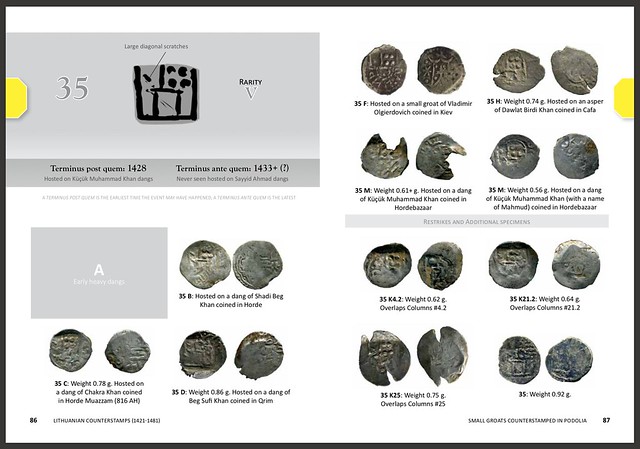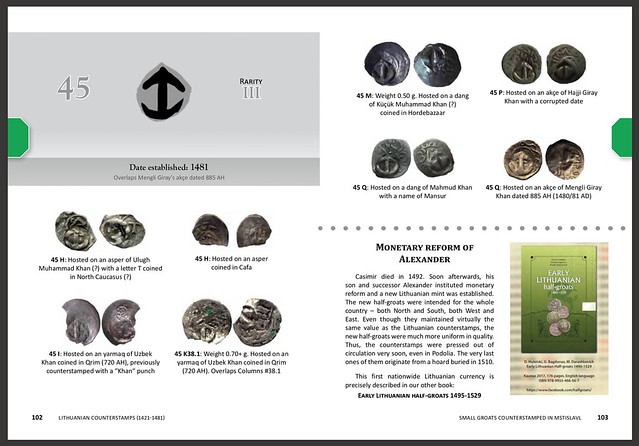
PREV ARTICLE
NEXT ARTICLE
FULL ISSUE
PREV FULL ISSUE
NEW BOOK: LITHUANIAN COUNTERSTAMPS 1421-1481Dzmitry Huletski has published a new book on 15th century Lithuanian counterstamps. Here's the book's Introduction and a link to where it can be purchased on eBay. -Editor
Indeed, the cost of counterstamping an old, void-of-guarantee coinage is significantly below the cost of producing a new currency. However, the countermarks do not contribute to the political prestige of the issuer, as their owned issued money would have done, and, perhaps more importantly, such money cannot become be used in international trade, since their exchange rate is guaranteed only within the state issuing them. Lithuanian countermarks circulated exclusively in areas of the Lithuanian-Horde frontier, almost without any penetration into the interior of the state. According to A.L. Ponomarev’s classification [Ponomarev 2011. P. 48-51] counterstamped coinages are divided according to their purpose into three groups:  1. Returning an old, depreciated coin to circulation. Such a need could arise, for example, upon the death of an old coin issuer – former guarantor of the monetary stability – either in absence of his clear successor and/or while gaining foreign influence on the market; 2. Designating an official exchange rate to an imported coin for circulation in the markets of the state; 3. Issuing Credit, or “war” money. The state puts counterstamped currency into circulation for a short time, pledging to buy them back in quiet times at an established rate. Counterstamping of Ulus of Jochi dangs with a stamp of Columns, initially a personal sign of the Grand Duke Vitovt the Great, began in the early 1420s and continued intermittently for a little less than half a century. These coins then echoed even later in the East border town of Mstislavl. The first “reference timepoint”, for the beginning of Lithuanian counterstamped coinage is September 1421, when Beg Sufi Khan died. He was the “Emperor of Solkhat”, and Vitovt’s protege on the “Small sultanate”’s throne of Qrim (Crimea). At the current level of our knowledge, it cannot be completely excluded that the counterstamping could have begun a little earlier. However, there are no compel- ling reasons to insist on this possibility at the moment. Thus, the first of the options described above (returning an old, depreciated coin to circulation) was the likely cause of action by Vitovt’s financiers. It was a need to maintain the currency of the state partially dependent from Lithuania during the civil war begun immediately after the death of Vitovt’s protege. It is important to note, that this currency – the Jochid dang – was also the main means of monetary circulation in the border areas of the Grand Duchy itself.  Later, the second cause of counterstamping (delivering an official exchange rate to an imported coin) also contributed to the longevity of the undertaking. An approx- imate equality of silver content of a Prague groat minted by the Czech king Vaclav IV, the main currency in contemporary Lithuania, and two Western-Jochid dangs of the 1420s provided extra convenience for trade. Still, even this convenience didn’t enable the small groats – Lithuanian counterstamps – to penetrate much inside the interior lands of the Grand Duchy. In Rus’, called грошики or полугрошки, this name of counterstamped dangs appears in various written sources originating from the Podolia region. They didn’t spread throughout Lithuania, like Prague groats, remaining artifacts of local, Lithuanian-Jochid borderland monetary circulation. The counterstamping was held perhaps in four regions of the Lithuanian-Horde frontier. During the first stage, dangs were counterstamped predominantly in Severia (somewhere close to Kursk, Trubchevsk, Novgorod-Severski), starting in the early 1420s for almost a decade. Possibly, these overstrikes were imposed in significantly reduced quantities, even into the 1430s. The second stage of counterstamping took place at mints that were situated further in the west, perhaps as far as the city of Kiev. Their production also dried up by 1430 or soon afterwards. The third stage of counter-stamping started in Podolia (close to Braclav and maybe Kamenec-Podolski) probably in the late 1420s, and lasted for the longest period of time, until about 1460. The latest known counterstamping of Jochid silvers was held in Mstislavl far in the northeast. Hardcover
For more information, or to order, see:

Wayne Homren, Editor The Numismatic Bibliomania Society is a non-profit organization promoting numismatic literature. See our web site at coinbooks.org. To submit items for publication in The E-Sylum, write to the Editor at this address: whomren@gmail.com To subscribe go to: https://my.binhost.com/lists/listinfo/esylum All Rights Reserved. NBS Home Page Contact the NBS webmaster 
|
